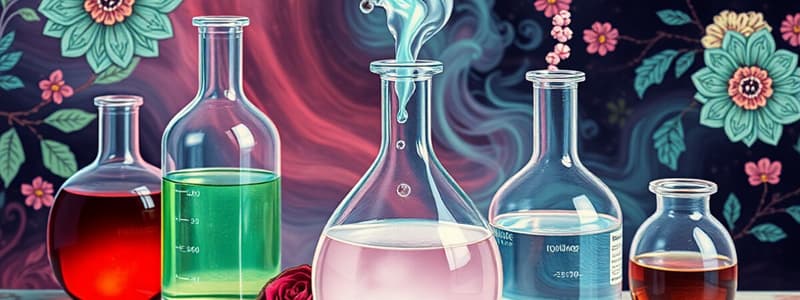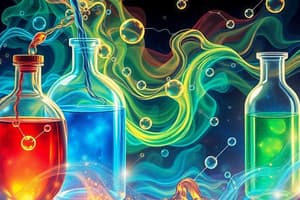Podcast
Questions and Answers
The law of conservation of mass states that mass cannot be _______ or _______ in a chemical reaction.
The law of conservation of mass states that mass cannot be _______ or _______ in a chemical reaction.
created, destroyed
A reaction in which two or more substances combine to form a new compound is called a _______ reaction.
A reaction in which two or more substances combine to form a new compound is called a _______ reaction.
synthesis
A reaction in which a compound breaks down into two or more simpler substances is called a _______ reaction.
A reaction in which a compound breaks down into two or more simpler substances is called a _______ reaction.
decomposition
A reaction in which one element replaces another in a compound is called a _______ reaction.
A reaction in which one element replaces another in a compound is called a _______ reaction.
A reaction in which ions from two compounds exchange places to form two new compounds is called a _______ reaction.
A reaction in which ions from two compounds exchange places to form two new compounds is called a _______ reaction.
The energy needed to start a chemical reaction is called _______ energy.
The energy needed to start a chemical reaction is called _______ energy.
A substance that increases the number of hydronium ions when dissolved in water is called an _______.
A substance that increases the number of hydronium ions when dissolved in water is called an _______.
A reaction between an acid and a base that produces a salt and water is called a _______ reaction.
A reaction between an acid and a base that produces a salt and water is called a _______ reaction.
A solution with a pH below 7 is classified as _______.
A solution with a pH below 7 is classified as _______.
An organic compound that contains only carbon and hydrogen is called a _______.
An organic compound that contains only carbon and hydrogen is called a _______.
A long chain of amino acids forms a _______.
A long chain of amino acids forms a _______.
The nucleic acid that carries genetic information in cells is called _______.
The nucleic acid that carries genetic information in cells is called _______.
A radioactive particle consisting of two protons and two neutrons is called an _______ particle.
A radioactive particle consisting of two protons and two neutrons is called an _______ particle.
The time required for half of a radioactive substance to decay is called its _______.
The time required for half of a radioactive substance to decay is called its _______.
Gamma radiation consists of high-energy _______.
Gamma radiation consists of high-energy _______.
What happens to mass during a chemical reaction?
What happens to mass during a chemical reaction?
How can you tell if a chemical reaction is occurring?
How can you tell if a chemical reaction is occurring?
What is the difference between a catalyst and an inhibitor?
What is the difference between a catalyst and an inhibitor?
Why do ionic compounds have high melting points?
Why do ionic compounds have high melting points?
What happens when an acid and a base react?
What happens when an acid and a base react?
How does pH relate to the concentration of hydronium ions?
How does pH relate to the concentration of hydronium ions?
What are two examples of organic molecules essential to life?
What are two examples of organic molecules essential to life?
Why do radioactive elements decay?
Why do radioactive elements decay?
How can half-life be used to determine the age of an object?
How can half-life be used to determine the age of an object?
What are the three types of nuclear radiation?
What are the three types of nuclear radiation?
The time required for half of a radioactive isotope to decay is called its _______.
The time required for half of a radioactive isotope to decay is called its _______.
The process by which a large nucleus splits into two smaller nuclei, releasing energy, is called _______.
The process by which a large nucleus splits into two smaller nuclei, releasing energy, is called _______.
The process in which small nuclei combine to form a larger nucleus, releasing energy, is called _______.
The process in which small nuclei combine to form a larger nucleus, releasing energy, is called _______.
A continuous series of nuclear fission reactions is called a _______.
A continuous series of nuclear fission reactions is called a _______.
The part of a nuclear power plant that absorbs excess neutrons to control the reaction is called a _______.
The part of a nuclear power plant that absorbs excess neutrons to control the reaction is called a _______.
The space around a charged object in which an electric force is exerted is called an _______.
The space around a charged object in which an electric force is exerted is called an _______.
The force of attraction or repulsion between charged particles is called _______ force.
The force of attraction or repulsion between charged particles is called _______ force.
A material through which charges can move freely is called a _______.
A material through which charges can move freely is called a _______.
A material that does not allow charges to move freely is called an _______.
A material that does not allow charges to move freely is called an _______.
The loss of static electricity as electric charges move off an object is called _______ discharge.
The loss of static electricity as electric charges move off an object is called _______ discharge.
The rate at which charges pass through a given point is called _______.
The rate at which charges pass through a given point is called _______.
The opposition to the flow of electric charge in a material is called _______.
The opposition to the flow of electric charge in a material is called _______.
A device that converts chemical energy into electrical energy is called a _______.
A device that converts chemical energy into electrical energy is called a _______.
Flashcards
Law of Conservation of Mass
Law of Conservation of Mass
Mass is neither created nor destroyed in a chemical reaction; it's conserved.
Synthesis Reaction
Synthesis Reaction
Two or more substances combine to form a single, new compound.
Decomposition Reaction
Decomposition Reaction
A compound breaks down into two or more simpler substances.
Single-Displacement Reaction
Single-Displacement Reaction
Signup and view all the flashcards
Double-Displacement Reaction
Double-Displacement Reaction
Signup and view all the flashcards
Activation Energy
Activation Energy
Signup and view all the flashcards
Acid
Acid
Signup and view all the flashcards
Base
Base
Signup and view all the flashcards
Neutralization Reaction
Neutralization Reaction
Signup and view all the flashcards
Acidic Solution
Acidic Solution
Signup and view all the flashcards
Basic Solution
Basic Solution
Signup and view all the flashcards
Hydrocarbon
Hydrocarbon
Signup and view all the flashcards
Protein
Protein
Signup and view all the flashcards
DNA
DNA
Signup and view all the flashcards
Alpha Particle
Alpha Particle
Signup and view all the flashcards
Half-Life
Half-Life
Signup and view all the flashcards
Gamma Radiation
Gamma Radiation
Signup and view all the flashcards
What happens to mass in reactions?
What happens to mass in reactions?
Signup and view all the flashcards
Signs of a Chemical Reaction
Signs of a Chemical Reaction
Signup and view all the flashcards
Catalyst vs. Inhibitor
Catalyst vs. Inhibitor
Signup and view all the flashcards
Why ionic compounds melt high?
Why ionic compounds melt high?
Signup and view all the flashcards
Acid and Base Reaction
Acid and Base Reaction
Signup and view all the flashcards
pH Relation to Acidity
pH Relation to Acidity
Signup and view all the flashcards
Essential Organic Molecules
Essential Organic Molecules
Signup and view all the flashcards
Why Radioactive Elements Decay?
Why Radioactive Elements Decay?
Signup and view all the flashcards
Age Determine by Half-life
Age Determine by Half-life
Signup and view all the flashcards
Types of Nuclear Radiation:
Types of Nuclear Radiation:
Signup and view all the flashcards
Half-life
Half-life
Signup and view all the flashcards
Nuclear Fission
Nuclear Fission
Signup and view all the flashcards
Nuclear Fusion
Nuclear Fusion
Signup and view all the flashcards
Study Notes
- According to the law of conservation of mass, mass cannot be created or destroyed in a chemical reaction.
Chemical Reactions
- Synthesis reactions involve two or more substances combining to form a new compound.
- Decomposition reactions involve a compound breaking down into two or more simpler substances.
- Single-displacement reactions involve one element replacing another in a compound.
- Double-displacement reactions involve ions from two compounds exchanging places to form two new compounds.
- The activation energy is the energy needed to start a chemical reaction.
Acids and Bases
- An acid increases the number of hydronium ions when dissolved in water.
- A base increases the number of hydroxide ions when dissolved in water.
- Neutralization is a reaction between an acid and a base that produces a salt and water.
- A solution with a pH below 7 is classified as acidic.
- A solution with a pH above 7 is classified as basic.
Organic Chemistry and Biochemistry
- A hydrocarbon is an organic compound that contains only carbon and hydrogen.
- A long chain of amino acids forms a protein.
- DNA is the nucleic acid that carries genetic information in cells.
Radioactivity and Nuclear Chemistry
- An alpha particle is a radioactive particle consisting of two protons and two neutrons.
- Half-life is the time required for half of a radioactive substance to decay.
- Gamma radiation consists of high-energy electromagnetic waves.
- During a chemical reaction, mass is conserved; the total mass of reactants equals the total mass of products.
- Signs of a chemical reaction include gas production, color change, temperature change, or precipitate formation.
- Catalysts speed up a reaction, while inhibitors slow it down.
- Ionic compounds have high melting points due to the strong electrostatic forces between oppositely charged ions.
- Acids and bases undergo neutralization, forming a salt and water.
- A lower pH indicates a higher concentration of hydronium ions, making the solution more acidic.
- Proteins and nucleic acids are two examples of organic molecules essential to life.
- Radioactive elements decay because their nuclei are unstable and break down into more stable forms, releasing radiation.
- Half-life can determine the age of an object by measuring the remaining amount of a radioactive isotope.
- Alpha particles, beta particles, and gamma rays are the three types of nuclear radiation.
- The time required for half of a radioactive isotope to decay is called its half-life.
- Nuclear fission is the process by which a large nucleus splits into two smaller nuclei, releasing energy.
- Nuclear fusion is the process in which small nuclei combine to form a larger nucleus, releasing energy.
- A continuous series of nuclear fission reactions is called a nuclear chain reaction.
- The control rod of a nuclear power plant absorbs excess neutrons to control the reaction.
Electricity
- Electric field is the space around a charged object in which an electric force is exerted.
- Electric force is the force of attraction or repulsion between charged particles.
- A conductor is a material through which charges can move freely.
- An insulator is a material that does not allow charges to move freely.
- Electric discharge is the loss of static electricity as electric charges move off an object.
- Electric current is the rate at which charges pass through a given point.
- Resistance is the opposition to the flow of electric charge in a material.
- A cell converts chemical energy into electrical energy.
Studying That Suits You
Use AI to generate personalized quizzes and flashcards to suit your learning preferences.




